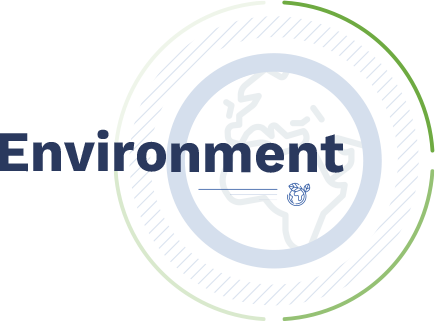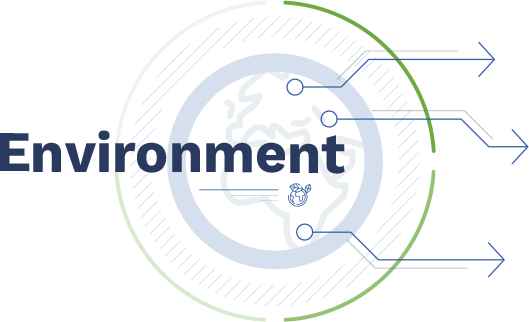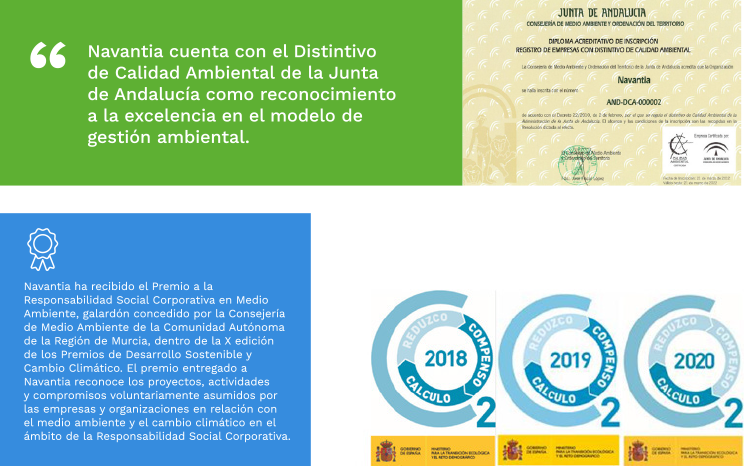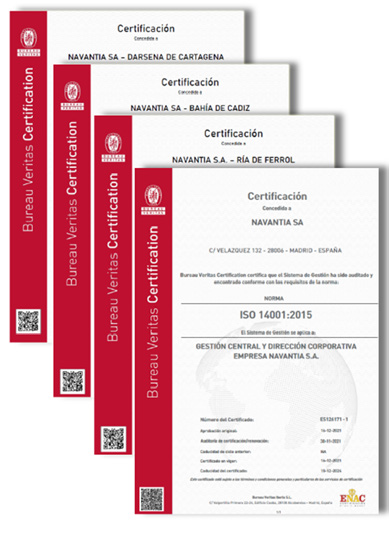







Navantia Circular & Ecodesign

Navantia contributes to the fight against climate change through a sustainable naval construction industry. Our factories are managed to minimise our impact on the environment and our products are designed and built in accordance with the very strictest international standards in regard to environmental protection, with special emphasis on the marine environment.
Ecodesign

- Eco-design consists of including environmental criteria in the initial design stages so that this variable can be considered as one more project requirement, thus ensuring its viability and success.
- Navantia has set its commitment to the environment as the corporate objective of eco-design, as a premise for its designs and production activity. This entails the need to remain at the forefront of technology in order to improve our future positioning and competitiveness, and the industrial transition towards sustainable, non-polluting, circular, competitive and environmentally neutral project designs.

Eco-design projects:
Application of eco-design criteria in new projects (modular frigate)

Green propulsion systems (Smart 4000, Hydrographic vessels)

Digital twin assistants for vessels aimed at reducing the environmental impact.

Navantia’s Eco Indicators
To calculate the carbon footprint, the results of the Lifecycle Analysis were used. This is expressed in kg of CO2 equivalent per tonne of vessel in order to standardise the index and to generalise its application to the rest of the vessels. |
This is calculated in accordance with the IMO standard, which measures the emissions of a vessel over its capacity. This is a merchant vessel standard, and therefore applying it to military vessels is excluded from it, requiring adaptation of the calculations to our activity. |
To calculate the carbon footprint, the results of the Lifecycle Analysis were used. This is expressed in kg of CO2 equivalent per tonne of vessel in order to standardise the index and to generalise its application to the rest of the vessels.
This is calculated in accordance with the IMO standard, which measures the emissions of a vessel over its capacity. This is a merchant vessel standard, and therefore applying it to military vessels is excluded from it, requiring adaptation of the calculations to our activity.

Zero waste:
The new business model put forward in accordance with the circular economy presents us with the first opportunity to change how we produce and consume since the industrial revolution, in a search to decouple economic growth from the consumption of resources and environmental impact in order to ensure a prosperous society.
The basic principles of the waste policy are the protection of human health and the environment. The order of priority in the waste policy is prevention (in regard to producing waste), preparing it for reuse, recycling and other types of recovery (including for energy), and finally the elimination of any remaining waste. These actions are covered in Navantia’s waste prevention, reduction, reuse, recycling and recovery policies.
Navantia promotes projects related to the circular economy as part of its awareness of their importance as key elements in the transformation towards a more innovative, competitive and responsible growth and development model. This model permits maximising available resources so that they remain for the longest possible time in the production cycle and reduce the amount of waste that is produced, exploiting any unavoidable waste to the maximum.
On the basis of these premises, the aim is to recycle or harness the largest variety and amount of non-hazardous waste instead of sending it to a landfill. In view of the above, the waste recovery index is defined as the percentage of waste assigned to

Zero Waste Projects:
Increasing waste recovery by over 90%, prioritising direct recycling. Reducing the percentage of hazardous waste by 10%.

Sustainable Centres:
Ensuring the continuity of energy consumption from renewable sources.
Minimising energy and water consumption per working hour by 30%.
Studying the design of a sustainable shipyard.
To ensure over 90% of our employees are familiar with the environment initiatives.
Sustainability watchdog.
Developing a source of knowledge on sustainability through models that predict exposure to risks and GHG emissions according to scenarios.

All our centres have been certified as Zero Waste.
Bureau Veritas have evaluated the waste control and monitoring system at all Navantia’s sites and have issued a Zero Waste certificate for all of them.

Climate change

Navantia contributes to the fight against climate change through a sustainable naval construction industry. Our factories are managed to minimise our impact on the environment and our products are designed and built in accordance with the very strictest international standards in regard to environmental protection, with special emphasis on the marine environment.
Navantia, committed to Net Zero by 2040.
By implementing climate change mitigation and adaptation measures, highlighting the creation of a Decarbonisation Plan.
In order to align itself with this context and the creation of its new Sustainability Strategy, Navantia has set itself the target of 55% decarbonisation by 2030 and 100% by 2040 (Scopes 1 and 2), undertaking to measure and reduce the Carbon Footprint resulting from its activity.
Decarbonisation Plan
Navantia is implementing a Decarbonisation Plan for scopes 1 and 2, and is also considering and measuring scope 3.
In its commitment to this goal in the regions where it operates, Navantia is implementing initiatives to reduce and offset its carbon footprint.



Navantia Seanergies business: Promoting Clean Energy.
Navantia partakes in producing clean energy through the construction of platforms for the offshore wind farms market. In recent years, the company has taken part in the construction of fixed and floating structures and installations that offshore wind farms require.
Through these initiatives, Navantia reinforces its commitment to a clean energy transition and its contribution to green recovery and employment associated with future renewable energy projects.
- International leader in the offshore construction sector: Navantia has carried out 11 marine wind farm development projects in 5 different countries since 2014.
- We specialise in fixed and floating foundations, and electricity substations for offshore wind power.
- Insofar as hydrogen is concerned, the company exploits the developments it has headed up in the AIP system of S-80 submarines as a growth vector within the framework of hydrogen technologies, which will be a key factor in decarbonising the shipping sector.

Recognitions


Environmental Certificates
All Navantia’s production sites have been certified in accordance with ISO 14001:2015: Cadiz Bay, Ría de Ferrol and Cartagena Dock, and also our Headquarters in Madrid.

Biodiversity & the marine environment

Navantia contributes to the fight against climate change through a sustainable naval construction industry. Our factories are managed to minimise our impact on the environment and our products are designed and built in accordance with the very strictest international standards in regard to environmental protection, with special emphasis on the marine environment.
Projects:
Navantia’s Ecosystem: Greenhouse Gas (GHG) emissions offset project through reforestation (Navantia Forest) or blue carbon sequestration

Biodiversity and business: outreach of the Taskforce on Nature-related Financial Disclosures (TFND) criteria for corporate biodiversity (recovery of ecosystems / ecosystem services).
Navantia is committed to carrying out its activity in a way that is compatible with conserving biodiversity, and being proactive in achieving this. We have the objective of protecting marine and coastal ecosystems by promoting scientific research on marine technology.
The company adhered to the Biodiversity Strategy with the Biodiversity Foundation of the Ministry for Ecological Transition and Demographic Challenge in 2020, to show Navantia’s commitment to conservation and sustainable use of biodiversity.
The Biodiversity Foundation and Navantia also study joint collaboration formulae within the framework of the Red Natura 2000 Life Intermares project.
Navantia publishes data through the Global Biodiversity Information Facility (GBIF) thanks to the joint work with the National Biodiversity Information Node (GBIF.ES), sponsored by the Ministry of Science and Innovation, and managed by the Spanish National Scientific Research Council (CSIC). More specifically, data on benthic fauna in the marine ecosystem near to Navantia’s facilities have been published, based on monitoring plans regarding the recipient environment which are managed through the Environment Department.

